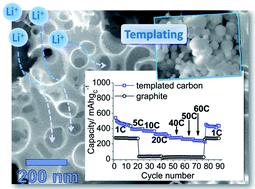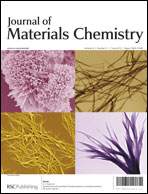Carbon materials with defined porosity are prepared using the nanocasting approach. The structural properties of the prepared carbon materials are examined by SEM, XRD, XPS, elemental analysis, nitrogen physisorption and Hg porosimetry. The materials exhibit an interconnected porous network with spherical pores in the macropore range, being a replica of spherical SiO2 particles. The average macropore size (300–700 nm) and surface area (35–470 m2 g−1) can be tailored by the choice of template and carbon precursor. More importantly, based on silica templates prepared by flame pyrolysis, the whole process, including HF etching of the template, can be easily industrialized. Lithium storage measurements are used to demonstrate the beneficial transport properties of the porous carbon materials which are referenced against non-porous carbons. The porous carbon materials exhibit high capacity (550 mA h g−1 at C/5) and excellent rate capability (90 mA h g−1 at 60C). Surprisingly, the excellent lithium storage properties are related to the macroporous framework rather than high surface area and/or micro- and mesoporosity.

You have access to this article
 Please wait while we load your content...
Something went wrong. Try again?
Please wait while we load your content...
Something went wrong. Try again?


 Please wait while we load your content...
Please wait while we load your content...